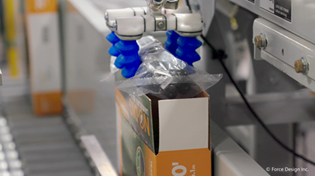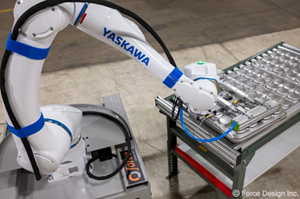Have you been scoping out robots and automation equipment for your facility lately? If you’re involved in manufacturing, you’ve probably been mesmerized by pictures and videos of automated assembly or packaging lines, robots that weld or paint or other industrial automation. Maybe you’ve even made some estimations about return on investment (ROI) and how automation could improve your operations.
But, the more time you spend shopping for robotic arms or reading blogs and product descriptions online, you realize just how complex it could become to automate a task.
Consider how many steps are involved in your manufacturing processes and the specs your finished products must meet. There’s usually more than one way to use robots and other automation equipment to carry them out. However, which is best? Add in the seemingly endless equipment and software options available, and you may arrive at these common questions:
-
What equipment do we actually need?
-
How do we get it to do what we need it to do?
-
Is it better to automate every step or just some?
What if we told you that as an automation equipment end-user, you don’t need to worry so much about these questions? In fact, all you really need to focus on is the expertise you already have: the steps in your manufacturing process, production goals, and available resources (i.e., labor, skills, and budget).
Why? You can rely on robot suppliers like Yaskawa Motoman and automation integrators, such as Force Design. Our roles in your journey to automation are different but complementary, and both are critical to building the right system for your needs.
Tools for the Tasks: the Robot Provider’s Role
 The first question robot providers ask of manufacturers is usually, “what’s your application?” In other words, what do you want the equipment to do? Common applications for robotics include packaging, machine tending, pick and place, assembly, palletizing, pick and pack, cutting, forming, welding, painting and more.
The first question robot providers ask of manufacturers is usually, “what’s your application?” In other words, what do you want the equipment to do? Common applications for robotics include packaging, machine tending, pick and place, assembly, palletizing, pick and pack, cutting, forming, welding, painting and more.
Another important question is this: "what are your automation goals?” Automation is used across industries for full or semi-automated processes, to improve quality, increase speed/throughput, ease labor challenges, move toward lean manufacturing, and ensure safety or ergonomics.
A supplier like Yaskawa Motoman offers a range of robots and systems, such as:
-
A wide range of industrial robot sizes and types
-
Various collaborative robot sizes
-
Standard robotic systems
-
Integrated vision and safety systems
-
State-of-the-art robotic controllers and programming options
-
Extensive training and support
Count on your equipment provider to have expertise in machine capabilities, features and compatibilities along with case studies and real-world examples. And, remember to learn about more than just robots! This includes learning about sensors, cameras, logic controllers, fixturing, safety equipment, infeed/outfeed devices, turntables, as well as other positioners and workholders.
Knowing your options is a great start, but it only gets you halfway. Determining which are best (and how to build a system) is where the automation integrator comes in.
Building a Complete System: the Integrator’s Role
Look for an integrator familiar with a variety of equipment options. An experienced integrator should be able to explain the advantages and trade-offs of various types of equipment with regard to your specific application. Their experience helps translate your process into what a machine can (or can’t) do, where biggest efficiency gains lie, and which tasks might be best left as a manual operation.
Manufacturers should understand there will always be some degree of customization involved in an automation project. Although there is a growing trend toward a do-it-yourself approach, most likely, robots and ancillary equipment won’t be ready to perform right out of the box – as many systems entail custom-designed equipment, programming, calibration, physical layout and debugging to get a system just right.
 You can make the integrator's development process more efficient by communicating each step in the manufacturing process and the required outcomes. For example, provide CAD drawings and part prints, work instructions, critical dimensions, as well as any important notes about upstream or downstream processes. Knowing how the new equipment must interact with equipment nearby (i.e., conveyor, racking, products and parts) is very important. These details help the integrator to coordinate all of the equipment optimally.
You can make the integrator's development process more efficient by communicating each step in the manufacturing process and the required outcomes. For example, provide CAD drawings and part prints, work instructions, critical dimensions, as well as any important notes about upstream or downstream processes. Knowing how the new equipment must interact with equipment nearby (i.e., conveyor, racking, products and parts) is very important. These details help the integrator to coordinate all of the equipment optimally.
Because they bring fresh eyes to the situation, integrators can design multiple ways to accomplish your goals and even help you plan for future expansion – should you choose to start small and automate more processes over time. By building a long-term relationship with your integrator, you’ll benefit from ongoing tech support and gain assistance transitioning to new equipment.
To learn more about the benefits of working with an automation integrator, please reach out to our dedicated experts at Force Design, or feel free to gain specific insight into robots and their peripherals at www.motoman.com – we’re here to help!
Seth Angle is a President of Force Design, Inc.

Connect on: